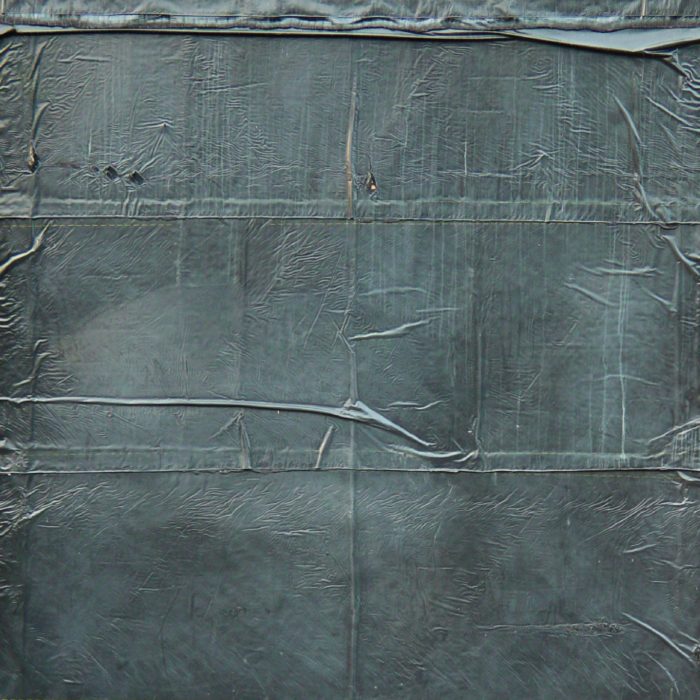An hour of alien textures—sundry hums and buzzes and intricate patterns across the sonic spectrum—is captured for an audio sculpture addressed to perceptual neglect. Inarticulate sound is given voice, background foregrounded, in its distillation of a lowercase aesthetic (cf. Ashley to Feldman, Ferrari to Gunter, Roden to Chartier) wherein detail abounds in low volume and gently massed textures. Amplifying and abstracting background noise, Garet homes in on particular resonant frequencies, working sources into a teeming hush, re-scoping the sheen of surfaces into a slow-mo jumble with drawn out passages of stark stillness. The chirp of data-driven devices, ventilator drone, electronic hum and metallic crepitus, the hushed thrum of the urban landscape and its remote echoes are all folded into a tonemass defying peripheralization. Garet seems to configure these sound, making Meta morph to achieve an ebb-flow of bleak lacunae ceding to squalls of teeming fervency. Through this, Garet targets the ostensibly dull ambience of our environs, bringing us closer to our quotidian soundtrack, rendering it grand and orchestral.
(igloomag.com)
The lowercase aesthetic and strategies have their origins with the vanguardists like Robert Ashley, Morton Feldman, and Luc Ferrari; and something of a global lowercase community emerged in the late ’90s and early ’00s when composers like Bernhard Gunter, Richard Chartier, and Steve Roden began exploring works that were deliberately understated in form, while details abound in the low volumes and gently massed textures. Richard Garet’s Meta is an austere distillation of many of the ideas proposed by these and many other likemined artists – the amplification and abstraction of background noise. Garet never states what specifically he captures in the overarching concept of background noise, but we can postulate that could mean the hidden chirping of data from the technologies that surround us, the hushed din of the urban landscape, the thumming hiss of ventilators, and the waves of static that silently glide on the paths of radio. As such, Garet heightens particular resonant frequencies, whisping any particular mundane sound source into that which resembles a sublime hush, and telescopes the sharp glare of unknowable, diamond-scraped surfaces into a slow-motion tumble with protracted passages of austere stillness. At times, Garet’s rarification process extracts sine waves of piercing intensity that shocks against the composition’s more emblematic forms akin to ASMR recordings for delicate sibilance and graceful electroacoustic poetics. Brilliant, as always.
(aquariusrecords.org)
You can always count on Richard Chartier’s label, Line to introduce us to new levels of subtlety in ambient minimalism. This disc by Uruguay-born, New York-based multimedia artist, Richard Garet is based on an installation in which background noise is brought to the fore; lifting previously present but unconscious sounds into our active awareness. What we get on the disc is an hour-long journey through alien textures, radioactive static clicks, humming and buzzing of many kinds and intricate sonic patterning at all thresholds of the audible spectrum. It’s the kind of music that sounds like it could have been beamed to Earth from a remote intelligence in a distant solar system, but is actually being made by mundane domestic appliances like the microwave oven, fridge-freezer and mobile phone.
Part of the thrill of this kind of music is the insectoid, alien quality of these sounds that we’ve heard before but probably not really paid much attention to them. Garet seems to structure and arrange the sounds too so that there appears to be an ebb and flow of intensity with stark, desolate passages building into periods of furiously teeming activity. This is most definitely a challenging, but engrossing listen, with some of the most punishing high frequency sine-wave surfing I’ve heard since I last checked out Sachiko M and Toshimaru Nakamura’s sound-mixer feedback jams.
(normanrecords.com)
Il più impressionante brano sonono dell’anno, un lavoro di sottili sfumature. FLUX: BEST OF 2015 LIST.
(fluxproject.altervista.org)
I hear the sounds I usually ignore. The sounds that lay outside of my subjective sensory pathway; the 30,000 sounds that don’t shape the way I perceive the world at any given moment (in contrast to the handful of sounds that do), all compacted into a foregrounded object. It’s a sculpture in ode to the plain of sensory neglect. Ventilator drones, electronic hums, metallic crinkles and distant echoes stack themselves into a beautiful tower that I can no longer push to my peripheral awareness or discard as irrelevant. I stand in the shadow of my own naivety and ill judgement.
As an installation, Meta takes the form of four transducers arranged into a six-foot square. The listener presses an ear against the wall and listens to the vibrations that judder through the surface and the ear itself. In this act, there is a metaphorical translation taking place – the listener actively focuses on the edge of their given space rather than a central object, inverting the prioritising arrangement that the mind subconsciously applies to any given soundscape. As a stereo, 52 minute piece of audio, Meta is an aquarium tank of debris drifting and rotating – a strange murk of numb frequencies and forgotten exhales that glide across the centre and then retreat again. Many of the textures feel suspended nervously in the air. Electric fence wiring pulled taut until it threatens to snap. Waves of static held miraculously above the point of crashing.
The movement is slow. Sometimes it’s fluid and effortless (hot waste air billowing out of a ventilation shaft), sometimes it’s loaded with pressure and stress (high frequencies dangled like chandeliers from solitary hairs). Garet tilts beautifully between states, and Meta transforms so elegantly that I find my muscles crunching nervously without even thinking about it. Solid blocks of bass frequency evaporate into floating feedback, while aircraft hangar reverberations curdle into clumps of white noise; the flux never ceases, and even as I find myself confronting the sounds that circumvent the centre of attention, they remain transient and unknowable, slipping through my fingers and dripping out the backs of my ears.
(attnmagazine.co.uk)
Già a partire dal titolo di questo suo nuovo lavoro, Richard Garet pare voler esporre ed esplicitare l’ “ambito” d’indagine che esso affronta. All’espressione meta è facile associare una varietà di suffissi, ciascuno a quel punto protagonista del nuovo termine ottenuto. E invece è proprio l’idea di “oltre” in sé che pare aver suscitato in Garet l’ispirazione per elaborare “Meta”: quel filtro che determina, su coordinate tutte da capire, il superamento del termine che lo segue, senza a dire il vero offrire particolari specifiche su quello che vi è “al di la’” dello stesso.
Nei cinquantuno minuti del disco, pubblicato da quella LINE divenuta ormai l’avamposto centrale dell’astrazione sonora elettronica, Garet cerca dunque di costruire un’ontologia dell’oltre slegandolo dal suo rapporto con un “qualcosa”, usando il suono come ambito-tipo e strumento al suo servizio. E giunge effettivamente ad una sua precisa determinazione, più metaforica che concettuale, nella forma di quell’impianto di “rumori” effettivamente percepibili dall’udito umano e onnipresenti attorno a noi, ma puntualmente estranei alla soglia dell’attenzione e la cui origine permane ignota.
Quest’opera si prefigura come l’esposizione di un concept che nasce e si sviluppa a livello mentale e riflessivo (“filosofico”, direbbe qualcuno), e non uno strumento all’interno del quale la riflessione si svolge e articola. A ciò va altresì aggiunto che l’esposizione stessa manca nel “solo audio” dell’importante componente fisico-percettiva data dall’ascolto nello spazio, offerta nel corso dell’installazione omonima ospitata in tre occasioni negli ultimi anni in Europa. Il disco è, semmai, una documentazione, una sorta di “relazione finale” sul progetto.
Quel che rimane dunque è una lunga composizione elettroacustica di circa cinquanta minuti, costruita su suoni strappati alla quotidianità più “nascosta” e meno apparente. Non pare esserci traccia d’umanità nelle sequenze che compongono la pièce, rimesse in ordine e legate fra loro con un’attenta attitudine documentale. Non vi sono field recordings o samples provenienti dal mondo concreto: al loro posto drones, brusii, fruscii, onde. Si tratta semmai della mimesi di quel che Garet ipotizza come idea di “oltre”, immanente la realtà ma che trascende la percezione che ne abbiamo.
Una ricerca“del” suono che possa rendere un’idea data e presupposta, dunque, piuttosto che una ricerca “nel” suono che trovi in esso le proprie risposte. Un’indagine che risulta convincente come dimostrazione di una tesi (l’ “oltre” va cercato in ciò che c’è ma ci sfugge) affascinante se collegata alla realtà attraverso l’esperienza fisica (l’installazione, in cui il background sonoro può appartenere ad un dato ambiente ed essere distribuito in maniera appropriata nello spazio), ma che fatica non poco a “darsi” tramite il solo ascolto – a meno di non avere un acousmonium in casa.
(ondarock.it)
As a purely audio experience, Richard Garet´s installation Meta is an extended field recording masquerading as a drone – quite “meta”, then.
On site (it has been mounted at three different New York galleries), we are informed that “transducers…are attached to the wall on each corner of a perfectly drawn six foot square… When the listener places his/her ear to the wall the work can be experienced differently every time…”, begging the question, Where are these sounds coming from – the wall itself or something on the other side of the wall? Garet wants to draw attention to the ostensibly dull ambience of our surroundings, bringing us in more intimate contact with the real soundtrack of our daily lives.
At the very beginning of Meta the CD, tones are sharp and not particularly ear-to-the-wall friendly, but they recede, as if having adjusted themselves to the strange environment, and settle into a low, soothing hum. Piercing or purring, either way, they certainly fulfil the remit of exposing sound that is ordinarily blocked out, like unattractive studs and struts behind smooth, decorative panelling. What could be dishwater snakes down what could be copper plumbing, some of which seeps out of faulty joints to interact ominously with the electrical wiring, the sizzle before the short circuit.
After all this twittering, something out of House of Leaves happens – a vastness opens up, where no vastness should be. Like coming round the bend on a hike and chancing upon a secret waterfall in the distance, or standing alone in a long, concrete underpass in the rain. Garet makes something grand and orchestral out of it, as it dilates wider and wider. The vastness morphs into a city subway, our ears floating from platform to track and up to the curved ceiling. A pleasant cacophony is achieved, “achieved” being the operative word, since it brings more attention to the possibilities of the manipulation of quotidian sound than their humdrum existence itself – to the efforts of the artist, in other words. As it recedes, we are treated to the gentle waterfall again. Unless it is an eddy of third-rail static.
(cyclicdefrost.com)


